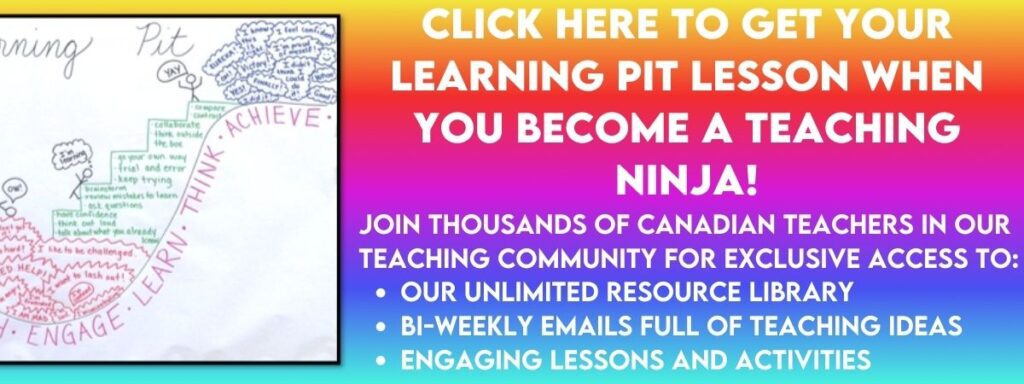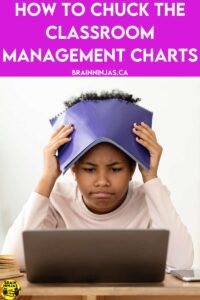
Did you know that it is possible to have good classroom management without the use of charts, rewards, or bribes?
The kids in our classrooms now are not the same as those in our classrooms even ten years ago. Many students struggle with regulation. Most students and families have not dealt with the trauma (yes, it’s trauma) that the global pandemic caused. This trauma trickles into the classroom daily.
We’re not saying you can’t reward your students when they exceed your expectations. The key here is to exceed. Come read about some of the classroom management strategies we use to help maintain the sanity of everyone in our classroom without the use of charts, rewards, or incentives.
Get Yourself in Check

First, not all strategies are going to work with every class and every situation. It is better to have a whole toolbox full of strategies that you can use. Refine them and use the ones that work best in each situation. These methods refer to the general classroom; some of these strategies are not going to work for a single student having a meltdown.
If you rule your class based on your own emotions, you’ve already lost the battle. Some students will spend all their time trying to rattle you. Don’t hand over that power. Keep your emotions in check until you can scream in your car on the way home.
Slow Down Your Classroom
The best piece of advice we can give all teachers in all situations is to slow down. When things go off the rails, it’s easy to panic and get riled up, which just makes things worse. Unless it’s life and death, some situations can be handled once everyone involved has had time to regain their composure.
Wait
We recently worked with a student teacher who was frustrated that students were chattering while she was teaching. But she didn’t pause to wait for students to follow her instructions. She continued teaching through it. Instead of this, we recommended waiting students out. And yes, this might mean that sometimes you have to wait a very long time. Your students aren’t going to learn anything if a few students are off doing their own thing anyway. Stop the lesson. Stare them down and wait. And keep waiting. Then, don’t allow them to do anything else until they have shown you exactly how to act.
Be Consistent
Do not tell students you are going to do something, and then don’t do it. They will learn quickly that these are idle threats. Instead, repeat the behaviour you want to see. Expect the same thing from all students (of course, there are exceptions) at the same time.
When working with a large group, be realistic with your expectations. Communicate them. Defend them and then do whatever it is you have said you were going to do.
Build Relationships
Don’t roll your eyes until you’ve finished this paragraph.
Relationships are a double-edged sword because you are not going to like every single student. Some of them can be really difficult. Having a relationship with your students will not make all your classroom management problems disappear.
But, sometimes, getting to know a student can give you insight into why they act the way they do.
Teacher-Student
Take a genuine interest in your students’ well-being, respect their perspectives, and demonstrate empathy and understanding. Establishing a connection based on trust and mutual respect lays the foundation for effective classroom management. Instead of simply punishing them at recess, make them walk with you. Ask about their home life, hobbies, and interests. Remind them you are a human who wants them to succeed, but you aren’t going to allow them to spew chaos in your classroom.
Student-Student
Encourage collaboration, cooperation, and peer support within your classroom. Create opportunities for students to work together, celebrate each other’s successes, and contribute to a supportive learning environment. Remind them they are representatives of you. Build a team.
Take the time to get to know each student as an individual, including their interests, strengths, challenges, and learning styles. Provide personalized support and guidance to help students thrive academically and socially. This can be difficult and it takes time, but it can be worth the investment.
Be Clear
Teach Explicit Classroom Rules

Establish clear and explicit classroom rules and expectations from the beginning. Keep these simple. The “rules” can be as simple as “clean up after yourself” or “respect everyone’s right to learn.” When possible, have students create the rules. Of course, you will help get students to the rules you want in your classroom, but if they believe they’ve created the rules, they are more likely to follow them and help enforce them.
We have some activities about setting up classroom rules in our Group Roles and Processes Unit for Grades 4-6. Find it in our TpT Store ($USD) or our BN Shop ($CAN). We recommend the Survival Island activity for classroom rules.
Reinforce Expectations Constantly and Consistently
Consistently enforce classroom rules and consequences in a fair and equitable manner. Address misbehaviour promptly and calmly, using redirection, reminders, and logical consequences to encourage students to reflect on their actions and make better choices.
Nothing sets off students more than thinking something is unfair. If you have a student who needs exceptions, be clear and honest about why. Explain that you don’t need a classroom of referees. On the other hand, don’t let students think you have favourites or allow some students to get away with the same behaviour that gets punished by others.
Model Good Behaviour (and talk about the bad)
Don’t assume students will know how to act, what to do, or what your rules mean. Model positive behaviour and social-emotional skills for students to emulate. And you will likely need to model this over and over again. Demonstrate effective communication, problem-solving, and conflict-resolution strategies and provide opportunities for students to practice these skills in real-life situations.
One of the best resources we regularly use is Expected and Unexpected Behaviours for Grades 4-6. It looks at many different types of situations, how people “should” act, and what to do when they don’t happen. Find Expected and Unexpected Behaviours for Grades 4-6 in our TpT Store ($USD) or our BN Shop ($CAN).
We also have a version for younger students. Find Expected and Unexpected Behaviours for Grades 1-3 in our TpT Store ($USD) or our BN Shop ($CAN).
Promote Intrinsic Motivation
Many students are not motivated by good grades, stickers, or getting to the top of a chart. You will need to create a classroom where behaviour does not hinge on these things. The students who need those incentives are likely to fall in line anyway.
Create Meaningful Learning Experiences

Design engaging and meaningful learning experiences that tap into students’ interests, passions, and curiosities. Offer choice and autonomy whenever possible, allowing students to pursue topics they find personally relevant and engaging.
We know that not every lesson will be a masterpiece. That’s ok. We also know there are some teachers out there whose professional autonomy has been taken away, and they’re forced to use expensive programs written by universities or publishers. We’re sorry those are so boring and developmentally inappropriate. Try to add your sparkle when you can.
Inquiry-Based Learning and Project-Based Learning
Emphasize inquiry-based learning or project-based learning approaches that encourage students to ask questions, explore solutions, and make connections between their learning and the real world. Foster a sense of curiosity, discovery, and intellectual challenge in the classroom. It will make your classroom management so much easier when your students are busy learning.
Our blog post, The Reasons for Project-Based Learning, might help inspire you.
Give Feedback and Reflection
Provide constructive feedback and opportunities for self-reflection to help students monitor their progress, set goals, and take ownership of their learning. Encourage students to evaluate their own strengths and areas for growth and celebrate their progress along the way.
Look for opportunities to catch students following your expectations–especially the ones who might not always shine. Publicly thank them. Share their successes with the class. Find positive things to say. Students with behaviour challenges don’t get enough positive feedback to make up for the constant correcting.
If you don’t think you need to give positive feedback, think about the last insult you received. You can probably still name the person and what happened. But you probably can’t remember the last compliment you got. This is how the human brain works. It takes lots of positives to wash away that one negative comment.
Explain How Learning and Behaviour are Connected
Some students act out because they are frustrated while learning. We teach our students about the Learning Pit to help mediate some of that frustration. We have a whole blog post that goes into more detail. Read Use the Learning Pit to Teach Growth Mindset.
We also have this lesson, which is part of the Learning Pit. If you are already on our email list, you can find this lesson in our Resource Library. If not, we’ll send it directly to your inbox when you sign up for our email list.

Cultivate a Positive Classroom Culture
Ultimately, your classroom is your responsibility. If your class is out of control, it comes down to your strategies. Everyone will have good and bad days, but if your class is a problem day after day, you might need to change how you manage it. If your class acts differently (behaves) for other teachers, take a really honest look at your classroom management. You might realize that you are creating the problem. (And yes, sometimes there are just really tough classes. I’m still having nightmares from the 2014-2015 year).
Celebrate Effort
Recognize and celebrate students’ efforts, perseverance, and growth mindset. Don’t focus solely on outcomes or achievements. Emphasize the importance of effort, resilience, and continuous improvement in the learning process. This can be as simple as using a strategy or not tattling on someone when coming from recess.
Promote Empathy and Understanding

Foster a culture of empathy, kindness, and inclusivity where students respect and appreciate each other’s differences. Teach social-emotional skills such as empathy, compassion, and active listening to promote positive relationships and conflict resolution. These are directly connected to your classroom management.
Teach students how to deal with differences in a way that doesn’t demean or argue. Conflict resolution isn’t an intrinsic skill (spending five minutes on the internet demonstrates that). Teach students skills and work on them throughout the school year.
Build Student Agency
Empower students to take ownership of their learning and behaviour by involving them in decision-making processes and goal-setting. Provide opportunities for student leadership, voice, and choice to promote a sense of agency and autonomy in the classroom.
Here is a whole blog post about Creating a Sense of Agency in the Classroom. It has more strategies for how you can manage your classroom without charts.
Why Charts (and other rewards) Suck
There is a lot of empirical evidence that clip charts or behaviour charts do more damage than good for the vast majority of students. No one wants a big sign in the front of the classroom showing the rest of the world how you’ve screwed up. The students who “win” will win without these charts. But the students who can’t win because they struggle with behaviour will just fall deeper down the behaviour hole. It’s a jerk move to publicly embarrass students-even the ones who misbehave.
In our experience, charts are a short-term thing that just makes more work and ends up in the garbage. They are too black and white for the complexities of student behaviour. These labels of “good or bad” follow students around for years. They are arbitrary statements from a paper chart hung at the front of the classroom.
It’s a lot of work to keep on top of charts, or points, or whatever. You will be amazed at the time you will free up by not needing to maintain these types of behaviour systems. Use that time to foster a sense of agency instead.
Behaviour charts can actually undermine your efforts. For students who already struggle with behaviour, your chart is a constant reminder that they will never measure up. This means they are unlikely to try to reach the top of that chart.
What Are You Struggling With?
Let us know how classroom management is going in your classroom. What are you trying? What are you struggling with? Let us know in the comments below.






